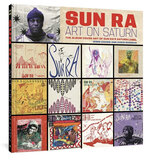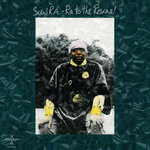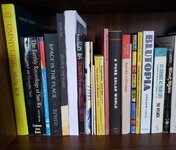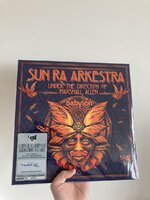You are using an out of date browser. It may not display this or other websites correctly.
You should upgrade or use an alternative browser.
You should upgrade or use an alternative browser.
The Latest News from Neptune - a Sun Ra thread
- Thread starter avecigrec
- Start date
Selaws
Well-Known Member
I will end up dotting this around a few threads because I imagine quite a few people will be interested.

 www.fantagraphics.com
www.fantagraphics.com


Sun Ra: Art on Saturn: The Album Cover Art of Sun Ra's Saturn Label
Drawn from private collections around the world, this is the first comprehensive collection of the Saturn label's printed record covers, along with hundreds of the best hand-designed, one-of-a-kind sleeves and disc labels decorated by Sun Ra and members of his Arkestra. Considered the foremost...

avecigrec
Well-Known Member
I will end up dotting this around a few threads because I imagine quite a few people will be interested.

Sun Ra: Art on Saturn: The Album Cover Art of Sun Ra's Saturn Label
Drawn from private collections around the world, this is the first comprehensive collection of the Saturn label's printed record covers, along with hundreds of the best hand-designed, one-of-a-kind sleeves and disc labels decorated by Sun Ra and members of his Arkestra. Considered the foremost...www.fantagraphics.com
View attachment 133100
Super duper way cool!
BoilerRhapsody
Active Member
Dipped my toes into the Sun Ra discography a couple of times (The Night of the Purple Moon, Atlantis) and never got that into it. But I just listened to the Lanquidity reissue and really enjoyed it. Can anyone point me in the right direction to more of his work that I might enjoy?
avecigrec
Well-Known Member
Dipped my toes into the Sun Ra discography a couple of times (The Night of the Purple Moon, Atlantis) and never got that into it. But I just listened to the Lanquidity reissue and really enjoyed it. Can anyone point me in the right direction to more of his work that I might enjoy?
These two will be your most Lanquidity-adjacent options:
imtheocean
Well-Known Member
Just popping in to say that Mrs. ImTheOcean and I are taking an online astronomy course through a local community college just for fun. I just submitted my homework on the Neptune chapter while listening to Sun Ra ~ Space is the Place. Seemed appropriate!
avecigrec
Well-Known Member
Dipped my toes into the Sun Ra discography a couple of times (The Night of the Purple Moon, Atlantis) and never got that into it. But I just listened to the Lanquidity reissue and really enjoyed it. Can anyone point me in the right direction to more of his work that I might enjoy?
I'd also recommend any of the following to branch further into the discography without hitting anything too out:
Omniverse
Jazz in Silhouette
Space is the Place (**currently spinning here**)
God is More Than Love Can Ever Be
Celestial Love
Sound of Joy
avecigrec
Well-Known Member
Just popping in to say that Mrs. ImTheOcean and I are taking an online astronomy course through a local community college just for fun. I just submitted my homework on the Neptune chapter while listening to Sun Ra ~ Space is the Place. Seemed appropriate!
Have you heard the latest news?
imtheocean
Well-Known Member
Have you heard the latest news?
I'll save that for the quiz on Sunday!
avecigrec
Well-Known Member
Ra to the Rescue!

Ra to the Rescue is one of the rarer albums in the Sun Ra canon. There's a reason, and it has nothing to do with quality content (or lack thereof). When Ra and his business partner Alton Abraham launched their pioneering independent Saturn label in Chicago in the late 1950s, and on thru the 1960s—by which time Ra had moved to New York—each new album was carefully curated, titled, packaged with a printed, illustrated sleeve, and promoted in ads and catalogs.
By the 1970s, when Ra and his band were based in Philadelphia, this process had begun to unravel. During that decade and the following one, Ra often issued albums without the involvement of Abraham (who had remained in Chicago). These releases—dozens of titles—were often hastily compiled, thematically mismatched, and issued in generic white sleeves adorned with homemade abstract artwork, glued-on photographs, and adhesive stickers. They were pressed in limited quantities and shipped to Rounder Distribution for sale, with a small percentage of the pressing reserved for the merch table at Arkestra gigs. Ra to the Rescue (RTTR, a palindromic acronym) emerged during this latter period.
These products arose out of economic necessity. The Arkestra was never a self-sufficient money-making enterprise. In order to feed the band, buy plane tickets, and put gas in the motorcade, Ra needed quick cash infusions. A new album, pressed in quantities of 200 to 500, could cover short-term outlays. Once issued and sold out, that album might never be pressed again. Rather than re-stock existing albums, Ra had a penchant for reconstituting the catalog with fresh material, even if it was juxtaposed with previously issued tracks.
Glenn Jones, who secured Sun Ra's peculiar distribution deal with Rounder, recalled: "By the late ’70s, the Arkestra was getting more frequent overseas bookings. Their LP sales to Rounder helped pay for passports, visas, and travel expenses. Whenever the band needed money (always), Sun Ra would select the recordings, send them out to be pressed, and Arkestra saxophonist Danny Ray Thompson would call me. Over the years, we carried maybe sixty different Saturn LPs."
The curatorial mindset behind many of these albums shall forever remain Mr. Ra's mystery. Some of these 1970s and '80s albums seem to have been programmed in random shuffle; hybrid pressings turn up which couple tracks from unrelated sessions, sometimes in clashing styles, often under new album titles. To the Ra enthusiast, this is not a bug—it's a feature. Recordings of public performances were often edited to omit applause before and after, leaving scholars to wonder whether these were live captures or studio sessions. Sleeve info was minimal or non-existent. Identifying recording locations, dates, track titles, personnel, and engineers would become a job for historians and archivists, who might disagree on details or simply remain mystified. You could formulate your own exegesis as to whether this was Sun Ra's carelessness, indifference or master plan.
Ra to the Rescue was initially pressed in limited quantities in 1983, but several of its tracks subsequently were reissued with incongruous tracks on the albums (commonly referred to as) When Spaceships Appear, Cosmo-Party Blues, Somewhere There, and Children of the Sun. Those album "titles" are in many cases simply the names of the first track on a particular side (these were scribbled in pen on otherwise blank labels). To complicate matters, some tracks were retitled for reasons that shall forever remain inscrutable.
The tracks on Ra to the Rescue were recorded at several locations over several years. Some were taped at New York's legendary (and now long-gone) avant-garde arts enclave, the Squat Theater. Squat was founded by Hungarian political dissidents and based in a cramped storefront at 256 West 23rd Street. Besides music, Squat was known for dramatic productions (from Chekhov to conceptual absurdism), which were staged in the theater's window overlooking the Manhattan sidewalk. From 1979 to 1982 the Arkestra appeared regularly at Squat; an unknown number of performances were recorded, a few released commercially. The Squat archives (at SquatTheatre.com) claim that Ra debuted there in August 1979 and performed on the premises 47 times, "to become our most frequent guest." The chronicle explains that "the fit between the Arkestra and the Squat Theatre was a natural one, as both were in essence creative communes." (Other recordings from Squat can be heard on the equally rare Saturn release Voice of the Eternal Tomorrow.)
The origins of the remaining tracks on Ra to the Rescue are speculative. The Earthling Recordings of Sun Ra (2nd ed.) calls them "odds and ends from various [1984 or 1985] concerts taped by Arkestra members." Michael D. Anderson of the Sun Ra Music Archive says they were recorded in 1984 by director Frank Cassenti for his documentary Mystery, Mr. Ra, at two Paris concerts: one at the Paris Jazz Festival, the other at the New Morning club. Many tracks in the documentary are fragments. The two titles included on this album which are heard in the film are different recordings. Anderson says "Mystery, Mr. Ra" was recorded at the festival and intended for release by Sun Ra, but was shelved.
Bandcamp

Ra to the Rescue is one of the rarer albums in the Sun Ra canon. There's a reason, and it has nothing to do with quality content (or lack thereof). When Ra and his business partner Alton Abraham launched their pioneering independent Saturn label in Chicago in the late 1950s, and on thru the 1960s—by which time Ra had moved to New York—each new album was carefully curated, titled, packaged with a printed, illustrated sleeve, and promoted in ads and catalogs.
By the 1970s, when Ra and his band were based in Philadelphia, this process had begun to unravel. During that decade and the following one, Ra often issued albums without the involvement of Abraham (who had remained in Chicago). These releases—dozens of titles—were often hastily compiled, thematically mismatched, and issued in generic white sleeves adorned with homemade abstract artwork, glued-on photographs, and adhesive stickers. They were pressed in limited quantities and shipped to Rounder Distribution for sale, with a small percentage of the pressing reserved for the merch table at Arkestra gigs. Ra to the Rescue (RTTR, a palindromic acronym) emerged during this latter period.
These products arose out of economic necessity. The Arkestra was never a self-sufficient money-making enterprise. In order to feed the band, buy plane tickets, and put gas in the motorcade, Ra needed quick cash infusions. A new album, pressed in quantities of 200 to 500, could cover short-term outlays. Once issued and sold out, that album might never be pressed again. Rather than re-stock existing albums, Ra had a penchant for reconstituting the catalog with fresh material, even if it was juxtaposed with previously issued tracks.
Glenn Jones, who secured Sun Ra's peculiar distribution deal with Rounder, recalled: "By the late ’70s, the Arkestra was getting more frequent overseas bookings. Their LP sales to Rounder helped pay for passports, visas, and travel expenses. Whenever the band needed money (always), Sun Ra would select the recordings, send them out to be pressed, and Arkestra saxophonist Danny Ray Thompson would call me. Over the years, we carried maybe sixty different Saturn LPs."
The curatorial mindset behind many of these albums shall forever remain Mr. Ra's mystery. Some of these 1970s and '80s albums seem to have been programmed in random shuffle; hybrid pressings turn up which couple tracks from unrelated sessions, sometimes in clashing styles, often under new album titles. To the Ra enthusiast, this is not a bug—it's a feature. Recordings of public performances were often edited to omit applause before and after, leaving scholars to wonder whether these were live captures or studio sessions. Sleeve info was minimal or non-existent. Identifying recording locations, dates, track titles, personnel, and engineers would become a job for historians and archivists, who might disagree on details or simply remain mystified. You could formulate your own exegesis as to whether this was Sun Ra's carelessness, indifference or master plan.
Ra to the Rescue was initially pressed in limited quantities in 1983, but several of its tracks subsequently were reissued with incongruous tracks on the albums (commonly referred to as) When Spaceships Appear, Cosmo-Party Blues, Somewhere There, and Children of the Sun. Those album "titles" are in many cases simply the names of the first track on a particular side (these were scribbled in pen on otherwise blank labels). To complicate matters, some tracks were retitled for reasons that shall forever remain inscrutable.
The tracks on Ra to the Rescue were recorded at several locations over several years. Some were taped at New York's legendary (and now long-gone) avant-garde arts enclave, the Squat Theater. Squat was founded by Hungarian political dissidents and based in a cramped storefront at 256 West 23rd Street. Besides music, Squat was known for dramatic productions (from Chekhov to conceptual absurdism), which were staged in the theater's window overlooking the Manhattan sidewalk. From 1979 to 1982 the Arkestra appeared regularly at Squat; an unknown number of performances were recorded, a few released commercially. The Squat archives (at SquatTheatre.com) claim that Ra debuted there in August 1979 and performed on the premises 47 times, "to become our most frequent guest." The chronicle explains that "the fit between the Arkestra and the Squat Theatre was a natural one, as both were in essence creative communes." (Other recordings from Squat can be heard on the equally rare Saturn release Voice of the Eternal Tomorrow.)
The origins of the remaining tracks on Ra to the Rescue are speculative. The Earthling Recordings of Sun Ra (2nd ed.) calls them "odds and ends from various [1984 or 1985] concerts taped by Arkestra members." Michael D. Anderson of the Sun Ra Music Archive says they were recorded in 1984 by director Frank Cassenti for his documentary Mystery, Mr. Ra, at two Paris concerts: one at the Paris Jazz Festival, the other at the New Morning club. Many tracks in the documentary are fragments. The two titles included on this album which are heard in the film are different recordings. Anderson says "Mystery, Mr. Ra" was recorded at the festival and intended for release by Sun Ra, but was shelved.
Bandcamp
avecigrec
Well-Known Member
I got 0353 - we're so close!
Also looking forward to finally cracking this open.
Selaws
Well-Known Member
I always wonder if they ship them out in order of purchase? Im assuming its just random though.I got 0353 - we're so close!
Also looking forward to finally cracking this open.
avecigrec
Well-Known Member
I always wonder if they ship them out in order of purchase? Im assuming its just random though.
Yeah, hard to say. I'd assume your order went in before mine since I found out about this one from you, so I suspect they just get a random stack when it's time for fulfillment.
I should have a copy of Sleeping Beauty arriving tomorrow too. Gonna be a good weekend!
avecigrec
Well-Known Member
Great news!
The Arkestral Institute of Sun Ra has been listed as a historic Philadelphia landmark.

 www.nme.com
www.nme.com
The Arkestral Institute of Sun Ra has been listed as a historic Philadelphia landmark.

Sun Ra House listed as historic Philadelphia landmark
The Arkestral Institute of Sun Ra now has protective status
 www.nme.com
www.nme.com
avecigrec
Well-Known Member
Been lowkey celebrating the 108th anniversary of Sun Ra's Earthday around here. Been listening to a couple of digital albums not available on vinyl and doing some spring cleaning, including reorganizing my Sun Ra library. Minus half a dozen 'zines down on the pocketbook shelf (with my small 33 1/3 collection and VMP Classics booklets) this is my current collection of books by, about or prominently featuring Sun Ra:


Dtknuckles
Well-Known Member
Happy 98th Birthday to Marshall Allen. Amazing achievement!
And here I am struggling with 45
